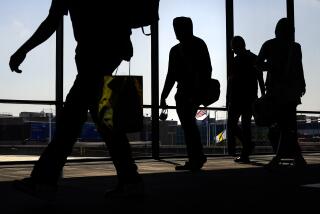Deregulation Cut Air Fares, DOT Study Says
- Share via
WASHINGTON — Air travelers fly to more cities and at lower fares than they did under the government-regulated air transportation system, according to a Department of Transportation study released Wednesday.
In revealing the findings of the nine-month study, Transportation Secretary Samuel K. Skinner declared that “deregulation has worked” and vowed to fight any effort to reverse it.
Skinner said competition among the nation’s air carriers has lowered costs and expanded service, making it possible for “greater numbers of people to afford travel.”
He conceded that “pockets of problems” have been created, such as congestion and higher fares for passengers traveling to or from airports where a dominant airline provides hub-and-spoke operations.
Skinner’s positive conclusion was quickly attacked by Sen. John Danforth (R-Mo.), who said the report actually adds to evidence of excessively high fares at some airports. Danforth has previously criticized airline deregulation for decreasing competition.
“The report shows that deregulation is not delivering to the traveling public fare benefits if you happen to live near a non-competitive airport,” said Danforth spokesman Steve Hilton.
Hilton said Danforth feels that it is “intolerable to have an industry that is neither regulated nor competitive.”
Although the number of airlines increased from 30 large carriers to 38 between 1979, when deregulation went into effect, and 1984, there currently are only 29 large carriers, and eight of them provide 90% of the service.
However, Skinner said current problems are minor when compared to the benefits provided by the deregulation of the airlines.
“The market forces unleashed by deregulation, by and large, have provided the public with more frequent and expanded service at lower costs,” Skinner said. “Any effort to regulate or reregulate air fares or service would do more harm than good.”
The report was based on data collected from 1979 to 1989 and analyzed by government and non-government aviation experts. Skinner said the review was prompted by public concerns over the competitive effect of airline mergers, airport congestion, changing fares and recent air crashes.
Fares overall have increased 14% since deregulation, but that represents a decline when adjusted for inflation, the study said. Since 1981, when prices rose due to an increase in jet-fuel costs, inflation-adjusted air fares have fallen 26%, the report said.
However, the average fare per mile at the nation’s eight most concentrated hub airports is an average 18.7% higher than the national average for similar airports, the report said. The most concentrated hub airports are Minneapolis; Cincinnati; Dayton, Ohio; St. Louis; Pittsburgh; Memphis, Tenn.; Salt Lake City, and Charlotte, N.C.
“This finding supports the conclusion that high hub concentration leads to high fares for passengers traveling to and from such cities,” the report stated.
Skinner acknowledged that some lawmakers, spurred by the inequities in the fare structures, have proposed bills to restore the industry to its regulated status. Although Skinner didn’t specifically mention any bills during the news conference, officials said later that he found particularly offensive a proposal calling for the re-establishment of a government board to set air fares and routes. That bill, sponsored by Sen. Howard M. Metzenbaum (D-Ohio) and Sen. Robert C. Byrd (D-W.Va.), would also direct the secretary to take “certain actions to improve service and promote safety in airline travel.”
“I’m not opposing all legislation,” he said, noting that he endorsed some parts of a Danforth bill. Skinner said he supports a Danforth provision that would allow passenger facility charges, by which airports would charge carriers an additional fee based on the number of people who board at that location. Those fees would be used for airport expansion.
“Passenger facility charges are one way we could expand the capacity of the system,” Skinner said.
The report cited capacity as one of the post-deregulation problems. “This points out the need for a full partnership between federal, state and local governments and the industry to expand capacity,” Skinner said.
Many carriers operate hub-and-spoke operations, where they transfer passengers to connecting flights from a centralized location. The number of airline hub operations has grown from five in 1979 to 25 in 1989.
Skinner said the higher fares that passengers pay in those hub locations “may be a fair premium” because those cities might not be profitable enough to support air service in a regulated environment.
“There are consumers who have benefited billions of dollars by deregulation,” he said. “That can’t be taken away from them.”
More to Read
Sign up for Essential California
The most important California stories and recommendations in your inbox every morning.
You may occasionally receive promotional content from the Los Angeles Times.













